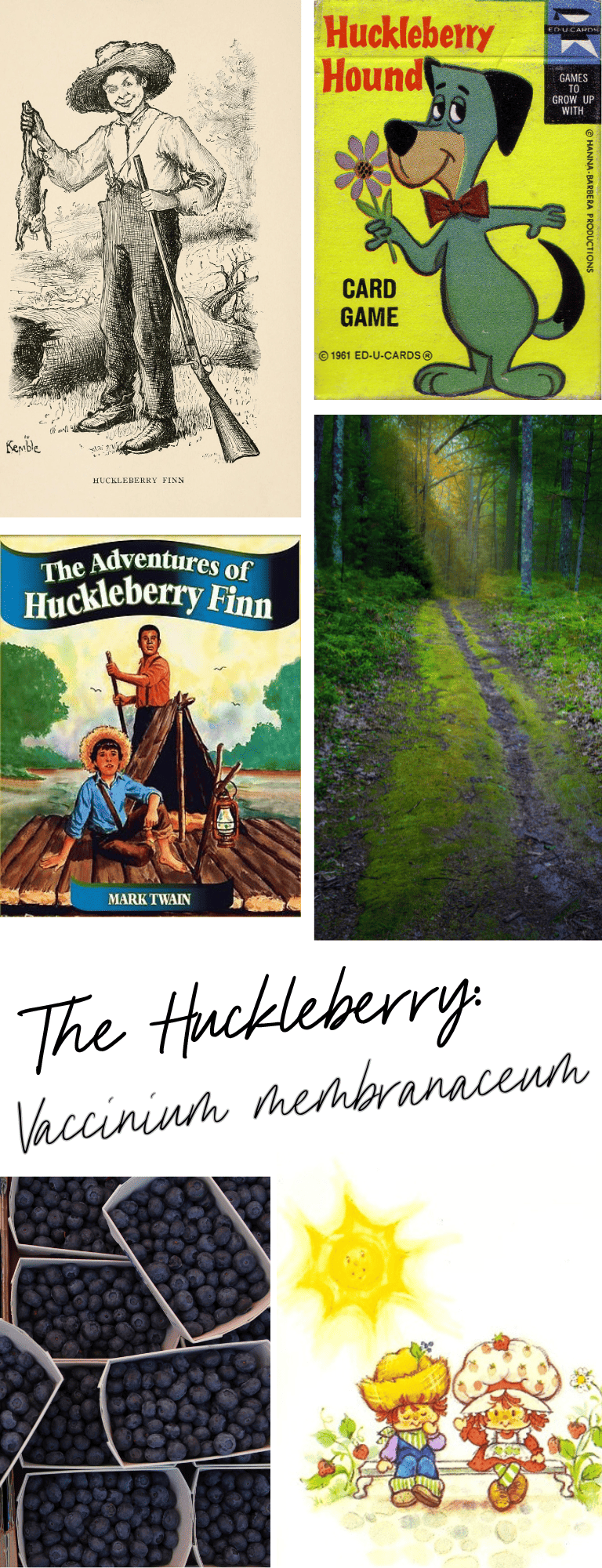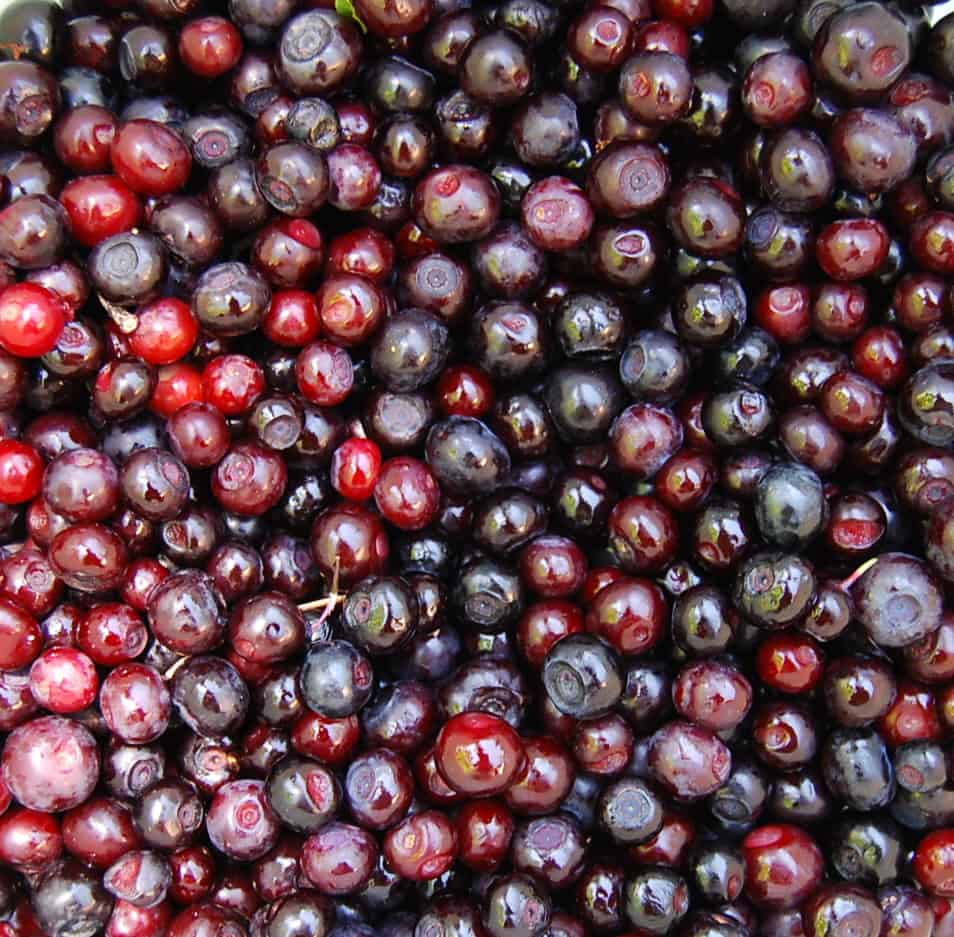Huckleberry Finn, Huckleberry Hound, Huckleberry Pie (Strawberry Shortcake’s best friend); I wonder if, even though these broadly known GenX cartoon characters are all named for the same fruit, do most people really know about the actual Huckleberry?
Huckleberry is similar to and in the same family as the blueberry. But, for those of you who do not live in the Northwest US or Western Canada, you might not know that it is one of the best-tasting fruits in existence.
And despite the tremendous and distinct flavor, I’ve only once seen them for sale – in a Campground market outside of Glacier Nation Park. Want to know why? And how you can grow them yourself?

1. Books – The Adventures Of Huckleberry Finn – Lantern, 2. 1961 Huckleberry Hound Ed-U-Cards Game, 3. Clafoutis Myrtilles & Charlotte aux Fraises Lamoureu. (the last picture is probably not huckleberries – though it was labeled that way). Blueberries have a distinct whitish coating, the berries are more blue and purple, and they grow bigger and more uniform in size.
My family lived in Pendleton, Oregon, briefly when I was in preschool. All I really remember is playing on my swing set (you know, the metal triangle death trap type that would go over if you swung too high) and picking huckleberries in the woods.
We made jam and syrup with them – in addition to eating them straight from the plant, and they imprinted on my 5-year-old self as one of the best-foraged fruits ever.

Growing Vaccinium membranaceum and Gaylussacia- Huckleberries
Huckleberries comprise a few varieties of vaccinium and Gaylussacia. The true huckleberry (Gaylussacia) has hard seeds, while the Vaccinium variety has soft seeds. Huckleberries grow wild (native) in forests, mountain slopes, and acidic soils, particularly in the Pacific Northwest and parts of the Rocky Mountains.
They are a charming symbol of the western regions where they thrive, and their name is often used affectionately to refer to something small. Like “a huckleberry over my persimmon” – something is simple but beyond your abilities.
My favorite use of the word, though, is to say, “I’m your huckleberry.” Val Kilmer says it best when he is telling Johnny Ringo that he’s the guy he’s looking for in the movie Tombstone (right before he ends him in a gunfight). I love that line.
They are challenging to cultivate commercially which is why you don’t see them in most markets. But you can purchase plants and cultivate them in your own garden. I’ve heard reports that plants are sometimes regionally available at Walmart. Baker Creek sells seeds. There are plants available by mailorder on Amazon, too.
Here are a few things to know about the challenge of growing huckleberries:
- Huckleberries have not been successfully cultivated on a large scale like other berries. They have specific growing conditions that are hard to replicate in a commercial farming environment. They typically thrive in wild, acidic soils, often in mountainous regions, and require a specific mycorrhizal fungus to grow, which makes cultivation challenging. It is worth a try if you are in the right region – but understand that you might not be successful.
- Huckleberries grow slowly and yield less than other commercially farmed berries. This slow growth rate and lower productivity make them less economically viable for large-scale commercial farming. But they are great for backyard foragers and gardeners.
- Huckleberries are mostly hand-picked in the wild, which is a labor-intensive and time-consuming process. The berries are small and delicate, making mechanized harvesting difficult without damaging the fruit. But again -this is why growing or foraging for them makes them so special.
- Huckleberries have a relatively short shelf life after being picked. This makes transporting them over long distances and storing them for extended periods problematic, reducing their commercial viability. When I saw them outside of Glacier National Park, they were frozen in bags. This is a great way to keep them until you are ready to use them.
- Overharvesting huckleberries from the wild can disrupt local ecosystems and impact wildlife that rely on them as a food source. Sustainable harvesting practices are essential to maintain the balance in these ecosystems. When I was a kid, I remember it being sort of secret where it was that we picked from wild plants.
- Huckleberries hold significant cultural and historical importance in some regions, especially to Native American tribes. There are traditions and rights associated with huckleberry harvesting that can limit commercial exploitation. Pay attention to any local restrictions.
- In the grocery store, there’s stiff competition from more easily cultivated and popular berries like blueberries and raspberries. These can be grown in a variety of climates and conditions. If you are lucky enough ever to find Huckleberries for sale – I suggest you snap these local treats right up and enjoy.
The more I think about it, I am glad I don’t see them in the grocery. It’s a good reason to head west and spend some time in the woods.
P.S. Did you also know that The Huckleberry Railroad was a heritage train located in Flint, Michigan?(There are also lots of huckleberries around the Great Lakes.) It ran so slowly it was said a person could jump off the train, pick huckleberries, and then jump back on the train with minimum effort.
We do have a couple of grocery stores here in Spokane that carry Huckleberries, frozen, during season, and for a hefty price. This past summer/fall they were not to be found in stores due to a shortage of supply apparently. Locally prices of anything “huckleberry” were raised as well. Since they can’t be “captively” grown those who go picking/hunting huckleberries keep their locations closely garded, and very secret. Some day we hope to find some, no luck so far. Here’s to another season. PS. I’m glad that my comment sparked some good memories, and a favorite for you as well.
desperately looking for this exact plant in plant or seed form to buy.
Have unfortunately purchased eight diff.kind from seed catalogs and they all suck, are not the guaranteed Idaho huckleberry I love and miss so much.
oh Ann that is is so frustrating! let us know if you find the right one (and where you got it)….if I come across, I will let you know.
Try seed savers exchange for huckleberry seeds. They have 50 seeds for $2.75. Don’t know if that is one of the ones you have tried or not.
Actually i believe the blue-ish looking ones (Bottom three) are not hucks. Their the ones you don’t wanna eat.. that first and third picture is heaven though. =D!!!!